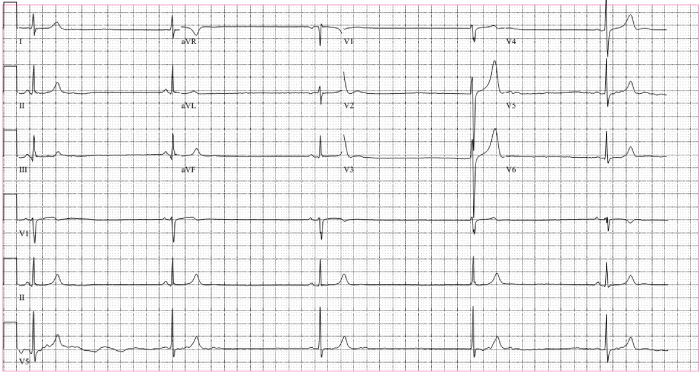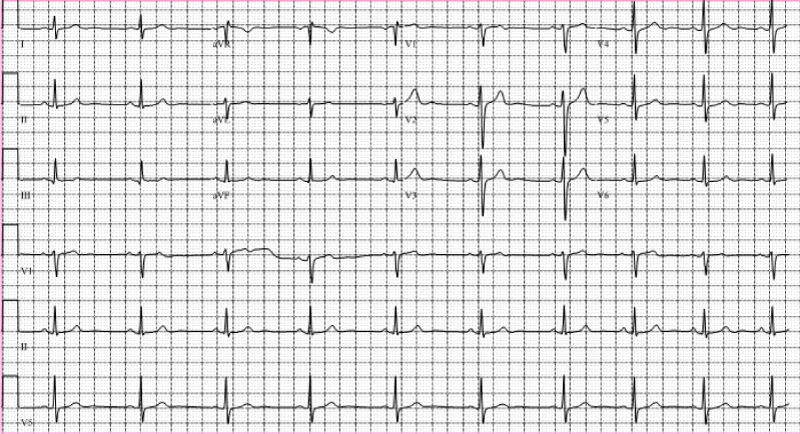Etoposide based combination chemotherapy is used with curative intent in patients with advanced testicular germ cell tumors [1-2]. Common side effects involve nausea and vomiting (up to 43%), alopecia (up to 66%), leukopenia (up to 91%). Cardiovascular side effects are rare, and hypotension only occurs in 1% - 2% of patients [3]. Etoposide is not known to cause thyroid dysfunction. We observed a case of bradycardia and QTc interval shortening after introduction of Etoposide based chemotherapy.
37-year-old male with stage IV mixed germ cell tumor of right testicle, with retroperitoneal lymphadenopathy and lung masses presented for cycle 2/4 of etoposide based chemotherapy and was found to be severely bradycardic with chest pain. Patient was not complaining of lightheadedness or dizziness. Vital signs were remarkable for blood pressure of 120/70 mm Hg, pulse of 28 beats per minute, respiratory rate of 20 breaths per minute, saturating 100% on room air. Physical exam did not reveal any murmurs or gallops, but patient did have bradycardia. Comprehensive metabolic profile was within normal limits, and complete blood count was remarkable for chronic thrombocytopenia of 97 10*3/uL. TSH level was 3.0 mIU/L and free T4 was 1 ng/dL. Electrocardiogram showed sinus bradycardia with a rate of 28 beats per minute, without ischemic changes (Figure 1). Electrocardiogram prior to initiation of chemotherapy showed a sinus rhythm with a normal heart rate (Figure 2). Cardiac injury panel was not suggestive of ischemia. Chest x-ray and CT angiography of the thorax were also normal. The patient was treated with atropine on presentation and heart rate normalized transiently, but eventually became bradycardic again. Of note, the patient had episodic bradycardia following his first cycle of chemotherapy as well, and the electrocardiogram before the first cycle of chemotherapy showed heart rate was within normal range. Nuclear stress test was also done and it did not suggest ischemic changes. Patient was discharged and advised to avoid beta-blockers. On outpatient follow up, he was noted to have returned to normal sinus rhythm. Chemotherapy was resumed with cardiac monitoring.

Figure 1: Electrocardiogram after patient was started on Etoposide. QTc interval < 340 msec.

Figure 2: Electrocardiogram before patient was started on Etoposide. QTc interval 400 msec.
Onset of bradycardia and QTc interval shortening in our patient appears to be correlated with introduction of Etoposide. Etoposide can cause electrolyte abnormalities such as hypomagnesaemia, hypokalaemia and hypocalcaemia, although not present in our case to account for his bradycardia [4]. The formation of reactive oxygen species causes some etoposide based adverse effects [4,5]. It is possible that reactive oxygen species formation may be the cause of cardiac muscle fiber damage resulting in transient bradycardia. Bradycardia is a rare side effect of etoposide, there is only one reported case in the literature. Exact mechanism of bradycardia is not known, but may be secondary to Etoposide deposition in SA node as well. These episodes appear to be short-lived, as evident in our patient, and resolved once given a holiday from chemotherapy agent. All patients should have close cardiac monitoring after induction of etoposide-based chemotherapy. Extra caution should be given to patients who are already on medications, which may subject them to bradycardia, such as beta blockers.
References
- Chovanec M, Hanna N, Cary KC, Einhorn L, Albany C (2016) Management of stage I testicular germ cell tumours. Nat Rev Urology 1: 164.
- Williams S, Birch R, Einhorn L, Irwin L, Greco FA, Loehrer PJ (1987) Treatment of disseminated germ cell tumours with cisplatin, bleomycin and either vinblastine or etoposide. N Engl J Med 316: 1435-1440.
- Pai VB, Nahata MC (2000) Cardiotoxicity of chemotherapeutic agents: incidence, treatment and prevention. Drug Saf 22: 263-302.
- Lee YK, Shin DM (1992) Renal Salt Wasting in Patients Treated with High-Dose Cisplatin, Etoposide, and Mitomycin in Patients with Advanced Non-Small Cell Lung Cancer. J Intern Med 7: 118-121.
- Kurosu T, Fukuda T, Miki T, Miura T (2003) BCL6 overexpression prevents increase in reactive oxygen species and inhibits apoptosis induced by chemotherapeutic reagents in B-cell lymphoma cells. Oncogene 22: 4459–4468.


